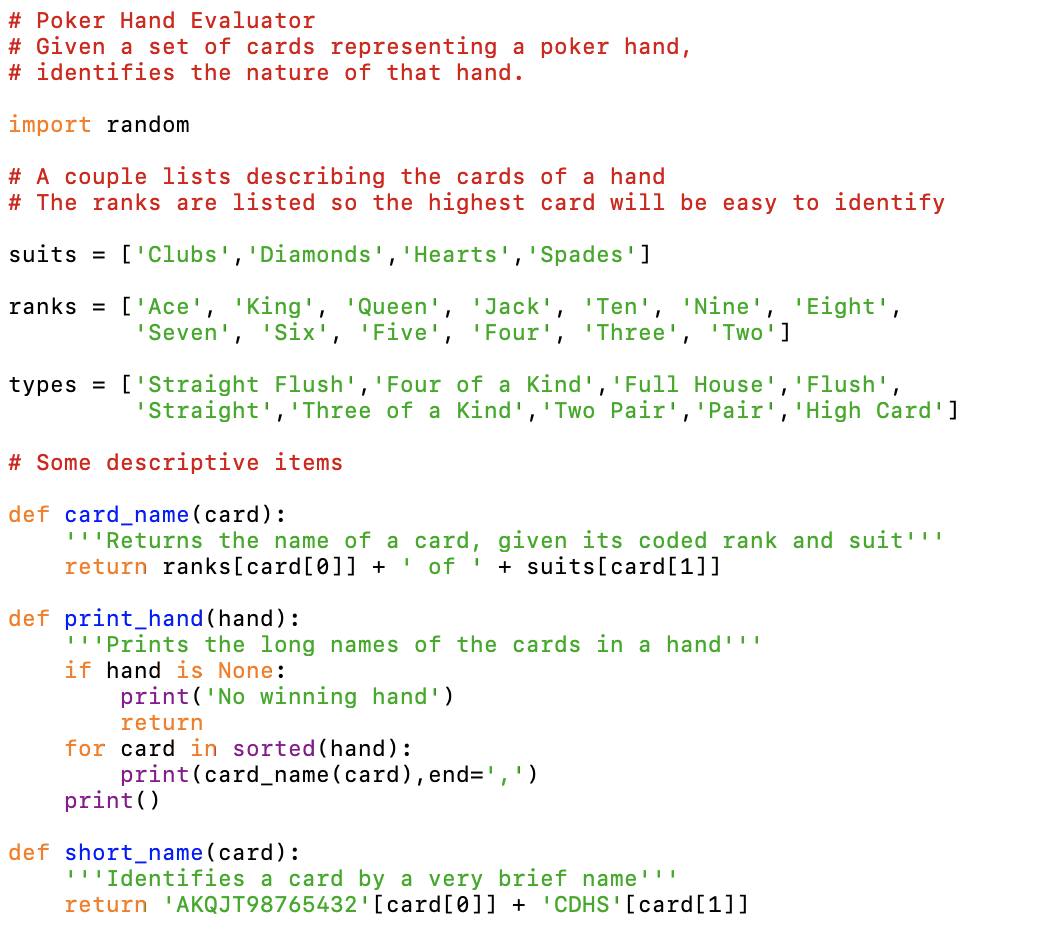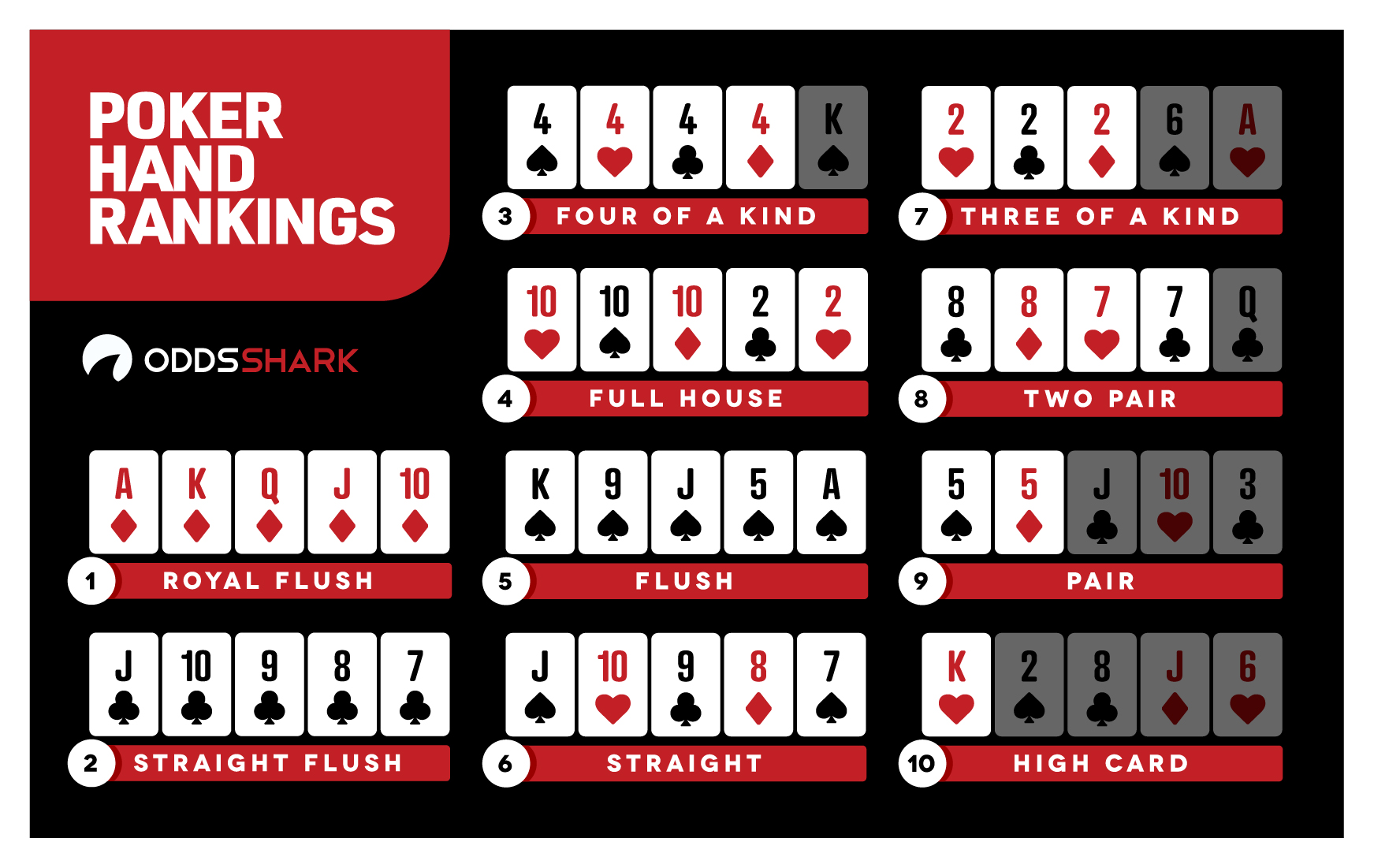This articles covers detailed description of uva 10315 the poker hands problem explanation and solution tricks with its source code in python. Keywords: poker hands, poker hands uva, poker hands problem, poker hands online judge, poker hands problem solution, uva 10315, uva 10315 solution python, poker hands source code, poker hands programming challenge.
Description:
- Treys is a pure Python poker hand evaluation library. Implementation notes. Treys is a Python 3 port of Deuces.Most of work is taken from msaindon's fork. Treys (originally Deuces) was written by Will Drevo for the MIT Pokerbots Competition.
- The hackerrank question asked me to write a program that would determine the best poker hand possible in five-card draw poker. We are given 10 cards, the first 5 are the current hand, and the second 5 are the next five cards in the deck. We assume that we can see the next five cards (they are not hidden).
- A quick overview of poker hands and how they are ranked. This section should demonstrates the power of Python's built-ins like set, sorted which makes solution to the problem of ranking Poker hands a very compact one, deriving inspiration from Peter Norvig's solution. (approx 10-15 mins).
- During a low poker game, the wild card is a 'fitter,' a card used to complete a hand which is of lowest value in the low hand ranking system used. In standard poker, 6-5-3-2-joker would be considered 6-6-5-3-2.
Overview
Ranking Poker Hands Python Games
In this talk, we start with a solution to the problem of ranking poker hands and then build up on it to simulate poker games. Eventually, we will look at simulating a large number of such games and see if there are any interesting strategies that can be developed, looking at the results of the simulations or it's just that it's random. We'll look at one such solution that uses Python standard library alone, with no external dependencies.

Description
From Wikipedia
Ranking Poker Hands Python Tutorial
Poker is a family of card games that combines gambling, strategy, and skill. All poker variants involve betting as an intrinsic part of play, and determine the winner of each hand according to the combinations of players' cards, at least some of which remain hidden until the end of the hand. Poker games vary in the number of cards dealt, the number of shared or 'community' cards, the number of cards that remain hidden, and the betting procedures.
Thus, poker is a very candidate for understanding how one can run a large number of random simulations.
Target Audience
Those interested in a game of Poker and Python - for the fun part of solving a problem in Python.

This talk should be a good introduction to using some features from standard library to Python programmers who are new to Python. There might be something for more experienced Python programmers as well.

Description
From Wikipedia
Ranking Poker Hands Python Tutorial
Poker is a family of card games that combines gambling, strategy, and skill. All poker variants involve betting as an intrinsic part of play, and determine the winner of each hand according to the combinations of players' cards, at least some of which remain hidden until the end of the hand. Poker games vary in the number of cards dealt, the number of shared or 'community' cards, the number of cards that remain hidden, and the betting procedures.
Thus, poker is a very candidate for understanding how one can run a large number of random simulations.
Target Audience
Those interested in a game of Poker and Python - for the fun part of solving a problem in Python.
This talk should be a good introduction to using some features from standard library to Python programmers who are new to Python. There might be something for more experienced Python programmers as well.
Ranking Poker Hands Python Cheat
People who are interested in understanding how to simulate certain real world scenarios, might also find the talk useful.
Talk Outline
The talk will cover following main topics. Most of the talk will walk through the code.
Ranking Poker Hands Python Game
A quick overview of poker hands and how they are ranked. This section should demonstrates the power of Python's built-ins like
set,sortedwhich makes solution to the problem of ranking Poker hands a very compact one, deriving inspiration from Peter Norvig's solution. (approx 10-15 mins).In Texas Hold'em a hand where aces, kings and queens pair up preflop is very rare. At a 9 player table this scenario unfolds roughly every 17,000 hands. The odds are 1:16,830 and the probability is 0.006%. Queens does happen every now and then, for example during this hand at the Bike. Odds of getting a pocket pair in texas holdem. 1.8 Preflop Texas Hold'em Odds; 1.9 Odds of connecting with the Flop in Hold'em; 1.10 Odds On the Flop in Texas Hold'em. 1.10.1 Outs; 1.10.2 Straight and Flush Draw Odds; 1.10.3 On the flop, when you have: 1.11 Odds of hitting a hand by the river from the flop. 1.11.1 On the flop, when you have: 1.12 All-in One-on-One in Texas Hold'em.
Next we look at what one Poker Game looks like and model it. Here we model a Poker Table with
'n'players and different stages of a poker game. This demonstrates modules from Python's standard libraryrandom,itertoolsandcollections. (approx: 5-7 mins)Finally we look at How can we answer questions by running simulations of such Poker games. List comprehensions etc. (approx: 5-7 mins)
- What percentage 'flop' winners end up being final game winners?
- Is Ace High during initial deal - really a good hand that can win?
- What about starting with a Pair?
- What about starting with same suit?